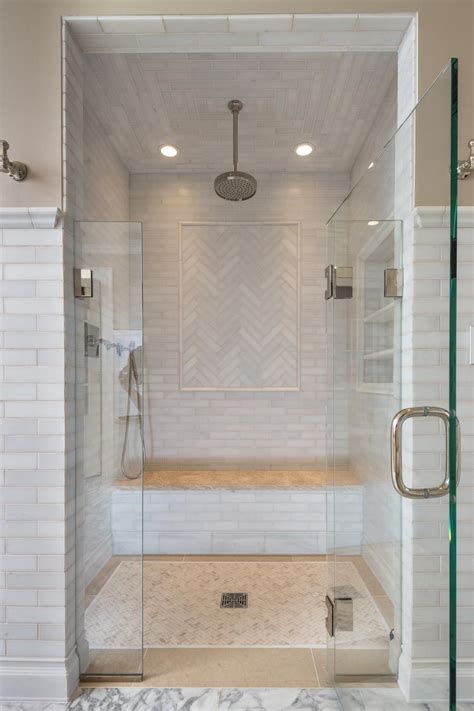What causes ceiling cracks
Are Ceiling Cracks Serious? When To Worry?
Table of Contents
So, are ceiling cracks serious? Let’s answer that by starting off with some good news…
Ceiling cracks aren’t necessarily a sign of structural damage. Yes, they can be a sign of serious structural damage but they often aren’t. It all depends on the size, type, and location of the crack.
This short article will give you basic information on the types of ceiling cracks, what causes them, and when you should contact a foundation professional.
Are ceiling cracks serious?
As we just pointed out, they could be. Usually, ceiling cracks are caused by one of two things: structural damage or settling (all structures settle to some extent after they’re built). If the ceiling cracks are due to normal settling, there’s usually nothing to worry about. However, if they’re caused by structural damage, you’ll need to take action and you can’t do that unless you know what to look for.
What causes cracks in ceilings?
There are two main causes of ceiling cracks: Structural damage and the natural settling that happens as a building ages. Ceiling cracks can also be caused by poor workmanship.
- Your home is getting older. Do you look and feel like you did when you were ten? Well, your home doesn’t either. Normal wear and tear – which includes foundation settling – happens naturally as a building ages and can cause cracks not only in the ceiling, but wall cracks and floor cracks as well.
- You have moisture damage. Ceiling cracks can also happen because of moisture damage. The moisture might be coming from the roof or from the floor immediately above the ceiling. Did a recent powerful storm sweep through your area bringing considerable rainfall? Is there a possible plumbing leak above the cracked ceiling?
- The floor above the ceiling is too heavy. Is there something heavy in the attic or on the floor above the cracked ceiling? Bathrooms especially need ceiling support because they contain heavy items like bathtubs.

- Something is wrong with your drywall. Drywall that hasn’t been properly installed will often crack, and cracks in ceiling drywall usually aren’t serious. For example, this can happen when drywall joints aren’t properly taped. In this case, the installer doesn’t use enough drywall mud while taping the joints and as a result the tape doesn’t stick. As the tape comes loose, it causes the drywall to crack.
- You have foundation problems. Unfortunately, ceiling cracks can also be a sign of serious structural damage. For example, foundation settlement can cause ceiling cracks. This happens because foundation settlement puts stress on the building’s frame. If ceiling cracks are caused by structural damage, you need to catch them early.
Learn more about Wall Crack Caused By A Foundation Problem.
Types of ceiling cracks
All buildings – wood, concrete, steel, or something else – move. Even though they look stationary, they aren’t. This imperceptible movement is caused by various things including seasonal temperature changes which cause the soil underneath the building to shrink and expand, as well as the kind of natural settling that happens over time to all structures. Because of this movement, a certain number of cracks in ceilings and walls are to be expected, and usually nothing to worry about. However, some cracks indicate a serious structural problem. So, you need to know how to spot those.
Even though they look stationary, they aren’t. This imperceptible movement is caused by various things including seasonal temperature changes which cause the soil underneath the building to shrink and expand, as well as the kind of natural settling that happens over time to all structures. Because of this movement, a certain number of cracks in ceilings and walls are to be expected, and usually nothing to worry about. However, some cracks indicate a serious structural problem. So, you need to know how to spot those.
- Thin, spiderweb cracks in the ceiling plaster or paint are probably nothing to worry about. Small cracks in ceiling plaster are normal and as we’ve just pointed out, can happen when there’s even a slight amount of natural building movement. Sometimes they’re caused by cracks in ceiling paint after years of build up. You’ll also find them on walls and floors. They usually aren’t a problem.
- Cracks that run across the ceiling and down the wall.
 Any crack that runs all the way across a ceiling and then down a wall is almost certainly the result of structural damage. Contact a foundation professional right away.
Any crack that runs all the way across a ceiling and then down a wall is almost certainly the result of structural damage. Contact a foundation professional right away. - Ceiling cracks accompanied by sagging. Not a good sign. Cracks accompanied by sagging need to be looked at immediately.
- Crack between wall and ceiling. If you notice a gap between your wall and ceiling, this is almost always a result of foundation settlement and should be looked at by a professional.
Ceiling cracks: When to worry
So, is it just a cosmetic problem associated with the structure’s age or something more serious? As we’ve been pointing out, it really depends on the size of the crack, its location, and what caused it. Here’s when you should contact a professional…
- Ceiling cracks along with sagging indicate a possible structural problem that needs immediate attention.
- One, big, continuous ceiling crack that goes across the ceiling and down a wall is almost certainly a structural issue.
 Contact a foundation professional right away for an inspection.
Contact a foundation professional right away for an inspection. - A large number of small ceiling cracks could also indicate a serious structural problem. Contact a professional.
- If your common sense tells you there might be a serious issue. This article is meant to provide pointers, but by no means is meant to replace the value of a professional foundation inspection.
If you see any of these cracks, start looking for other signs of structural damage. This will help you determine if the cracks are serious. Signs of structural damage include…
- Uneven floors that slope or sag.
- Doors and windows that stick.
- Cracks in flooring that aren’t limited to one tile. Look for cracks that go all the way across the floor in a straight line.
- Cracked or bowed walls.
- Wall rotation. This is caused by excess moisture under the foundation. As the outside edge of the foundation sinks into the soggy soil, the inside edge lifts up and causes the wall to rotate.

- Moldings that are cracked or out of place. This happens because things aren’t moving in sync.
- Stair step cracks in bricks or masonry.
- Walls that are no longer in contact with the ceiling or the floor.
- Porches or chimneys that have separated from the building.
- Water in your basement. This can be caused by cracks in the foundation wall.
Also think about whether there have been any recent earthquakes, landslides, problems with sinkholes, or anything else that could have caused structural damage.
How To Repair Ceiling CracksIf the ceiling cracks are merely cosmetic – i.e., paint and plaster build up – you can repair them by removing the old paint or plaster and then repainting or re-plastering. However, if the ceiling cracks continue to open and you notice they may be getting bigger, this could indicate differential settlement and the home may need underpinning.
Underpinning is about extending the foundation depth so that it rests on stable soil. At Bay Area Underpinning we install galvanized steel push piers. Our most common method of lifting and stabilizing foundations that are experiencing settlement. The procedure involves installing steel brackets to the foundation and then hydraulically driving the steel piers/pipe through the brackets and into the soil under reaching load bearing strata or bedrock. Once the piers have reach load bearing strata, a synchronized hydraulic lifting system raises the house as needed. Any cracks caused by settlement can typically close up and in some cases they will not close up. It all depends on the home, and how much lift will happen when the lifting process begins and finishes.
For more information, see Underpinning A House: What Every Homeowner Needs To Know.
Conclusion
All homes – even brand new homes – settle into the soil. When this happens you will see a few small cracks appear here and there, including on the ceiling. Most of the time, these small cracks do not indicate a major structural issue. However, it’s good to know what to be on the lookout for. That way, if any serious cracks do appear, you’ll be able to spot them and take immediate action.
Most of the time, these small cracks do not indicate a major structural issue. However, it’s good to know what to be on the lookout for. That way, if any serious cracks do appear, you’ll be able to spot them and take immediate action.
If you see any cracks you’re not sure about, contact a foundation professional. They’ll come out, perform an inspection, and if you do have structural damage they’ll determine what needs to be done.
If you’re in San Jose, Sacramento to Fairfield, CA, you can contact us for an inspection!
Steve Egloff
Steve is the CEO at Bay Area Underpinning, a foundation repair contractor serving the San Fransisco Bay Area, California. Bay Area Underpinning was founded in 2005 with the goal of providing a cost-effective, engineered solution to foundation settlement problems with an emphasis on educating customers to make them feel comfortable with the various methods of foundation repair.
Search
POPULAR
FREE Foundation Repair Guide
Download the free foundation repair guide for Northern California homeowners.
"*" indicates required fields
First Name*
Last Name
Your Email*
* Email Permission*Please send me emails about your company (we will not sell your personal information).
Get A Quote
Why Do I Have Cracks in My Ceiling? (6 Types of Cracks to Look Out For)
The origin of ceiling cracks can be difficult to decipher, especially because they come in all different sizes, patterns, and colorations. As a concerned homeowner, you need to be able to pinpoint the exact cause to execute the correct repair.
We know that diagnosing ceiling cracks can be a frustrating process, so we are here to help.
Dalinghaus Construction Inc. has been in the foundation industry for decades. Collectively, we have over a hundred years of combined foundation diagnostic and repair experience. After servicing thousands of foundations – we’re certain we can help you pinpoint where those ceiling cracks are coming from (whether you choose to work with us or not in the event that your ceiling cracks are caused by foundation damage.)
After servicing thousands of foundations – we’re certain we can help you pinpoint where those ceiling cracks are coming from (whether you choose to work with us or not in the event that your ceiling cracks are caused by foundation damage.)
After reading this article, you will be able to diagnose common ceiling cracks and determine their specific features, causes, and the average seriousness of each fissure. So you’ll know the right repair at the right time -
To give you the basics, we’ll cover:
- Hairline ceiling cracks
- Straight ceiling cracks
- Yellow or brown ceiling cracks
- Spiderweb ceiling cracks
- Cracks between the ceiling and wall
- Bowed ceiling and large ceiling cracks
So, let’s crack on –
6 Common Household Ceiling CracksHairline Ceiling Cracks
Hairline ceiling cracks are tiny, thin fissures that almost look like someone painted hair to the drywall. Hairline cracks are typically caused by plaster or drywall mud issues, not the drywall itself. Extreme fluctuations in humidity and temperature can result in plaster expansion and shrinkage (in direct correlation with the water absorption).
Hairline cracks are typically caused by plaster or drywall mud issues, not the drywall itself. Extreme fluctuations in humidity and temperature can result in plaster expansion and shrinkage (in direct correlation with the water absorption).
The continuous expansion and shrinkage weaken the adhesive properties of the drywall mud.
In addition, when a ceiling has multiple layers of paint, the odds of crazing – those fine hairline cracks – go up. Multiple layers of paint can also result in a scaly texture on your ceiling, similar to crocodile skin.
While hairline ceiling cracks might be an eyesore, they are not indicative of serious structural damage. They are usually addressed easily enough with a fresh coat of paint. Temperature and humidity control can help deter future hairline cracks from occurring.
Straight Ceiling Cracks
Straight ceiling cracks run in a straight line, so straight it almost looks like they were applied with a ruler.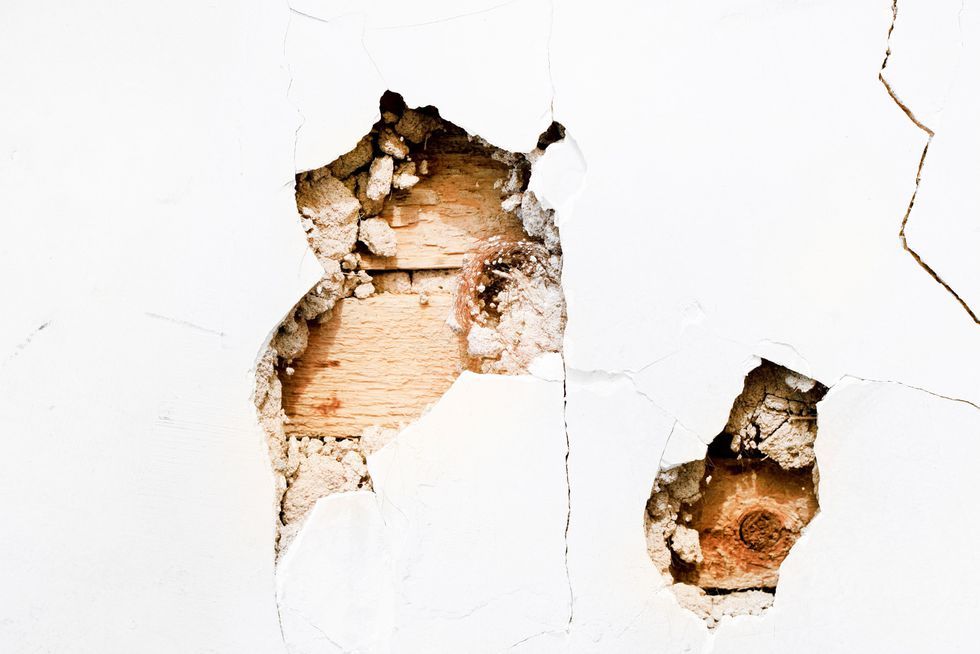 Generally, these cracks are straight because they follow the straight edge of the drywall tape along the drywall joint. Ceiling cracks tend to be fine and can generally be attributed to an insufficient amount of plaster used during the drywall installation. The drywall tape is unable to properly adhere to the joints and peels away due to a lack of strength.
Generally, these cracks are straight because they follow the straight edge of the drywall tape along the drywall joint. Ceiling cracks tend to be fine and can generally be attributed to an insufficient amount of plaster used during the drywall installation. The drywall tape is unable to properly adhere to the joints and peels away due to a lack of strength.
Foundation settlement can exacerbate poor tape jobs in addition to high humidity.
In short, straight lines are almost always the result of an incompetent drywall tape application. A professional can quickly address this by patch-and-painting. Straight ceiling cracks are not usually ominous or suggestive signs of serious structural damage, just human error.
Yellow or Brown Ceiling Cracks
Yellow, brown, and discolored ceiling cracks almost always point to water damage – whether it’s from a roof leak or a busted pipe. Depending on how fresh the leak is, these ceiling cracks may even be damp to the touch.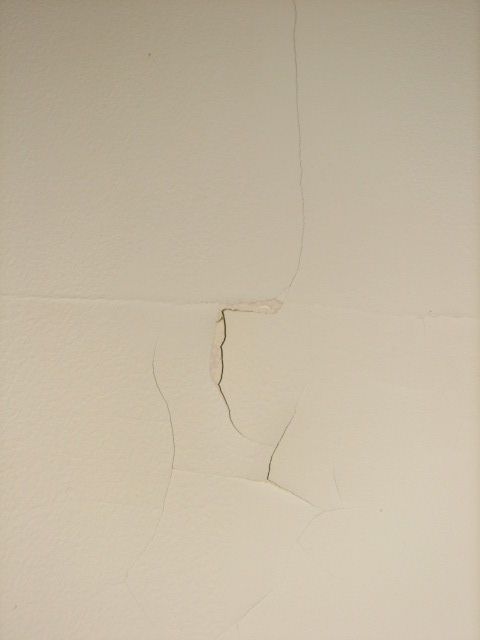
With yellow or brown ceiling cracks, it is imperative to determine the source of the leak and address it before repairing your drywall.
Discolored ceiling cracks generally are not a sign of serious structural damage, but unmitigated moistures can create a whole host of problems – mold, rotted drywall, and spalling (depending on the location and extent of the leak). You can repaint over these cracks if they’re small enough, larger cracks may require professional drywall replacement.
Spiderweb Ceiling Cracks
Spiderweb ceiling cracks branch out in a spiderweb pattern. Spiderweb ceiling cracks often signify foundation settlement (denoting compromised structural integrity).
When a home settles, it settles unevenly. This uneven settlement exerts undue pressure on the home’s foundation, which transfers this pressure up into the framing of the home and the drywall. Other foundation settlement signs to look for in addition to spiderweb ceiling cracks include:
- Out of square window and door frames
- Sloped floors
To learn more about the signs and symptoms of foundation settlement, read our article 5 Signs of Foundation Issues.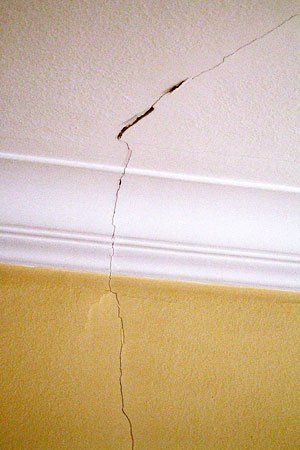
If your ceiling spiderweb cracks are smaller than 1/16th of an inch, there probably isn’t much to be worried about. Occasionally, drywall mud is applied too thinly and can result in spiderweb cracks after drying out.
Cracks Between the Ceiling and Wall
Ceiling cracks that seem to pull away from the wall are typically the result of truss uplift. Trusses act as the frame for the roof and ceiling and help determine its shape. Ceiling trusses are designed to be flexible and adapt to humidity and temperature fluctuations. Occasionally, usually due to extreme wind or weather fluctuations, the trusses can pull away from the ceiling.
This leaves an unsightly gap between your wall and ceiling. This gap is typically due to the incorrect attachment of the ceiling to a non-load-bearing wall. This is a more serious ceiling crack that needs to be dealt with by professionals, such as a construction company.
Bowed Ceiling and Large Ceiling Cracks
If your ceiling is bowing and scarred with large, obtrusive cracks down the middle – there is most likely severe structural damage.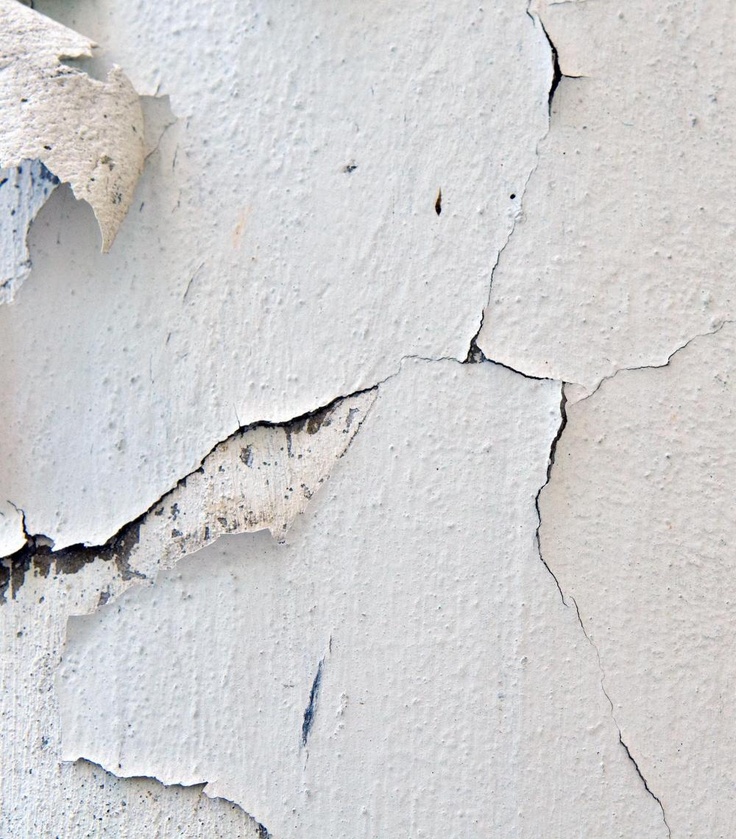 The structural integrity could be compromised by extreme water damage, an inordinate amount of weight on the floor above the ceiling, or foundation settlement.
The structural integrity could be compromised by extreme water damage, an inordinate amount of weight on the floor above the ceiling, or foundation settlement.
Foundation settlement can exert too much stress on the trusses and framing above your ceiling, causing your ceiling to warp and the sheetrock to crack. In order to determine if your foundation is settling, reach out to a foundation repair specialist near you for a foundation inspection.
Call the Right Repairmen or Repair the Cracks Yourself
In this article, you learned how to identify common ceiling cracks, determine their likely source of origin, and how seriously you should treat each fissure. This information will help guide you to whether you need to hire a professional or fix it yourself.
Where there are ceiling cracks, other cracks probably aren’t far behind, which can point to foundation issues or other problems that need to be addressed. Educate yourself. To learn more about sheetrock cracks in general, in your ceiling or walls, read our article Top 5 Primary Reasons for Sheetrock Cracks.
Are you worried that your ceiling cracks are symptomatic of foundation settlement? Or perhaps you just want to rule foundation settlement out? If you live in Southern California or Arizona and would like to book a free foundation inspection, click the link below –
Why do cracks appear on the ceiling and what to do about it? | House/renovation | Real estate
Elena Slobodyan
Estimated reading time: 3 minutes
7958
Category: Comfort
The appearance of cracks in the ceiling is not always the fault of the builders or the workers who made the repairs. Such defects can be caused by a variety of reasons: natural shrinkage of the house or natural disasters, non-compliance with the technological process, “aging” of the building, sudden temperature changes inside the room, excessive humidity, and so on.
What are the most common causes of cracks in ceilings?
Cracks in ceilings can appear due to shrinkage, structural vibrations of the house caused by an earthquake, poor-quality sealing of tile joints, use of poor-quality materials, lack of primer and putty layer, flooding by neighbors from above, and so on. Both ordinary ceilings and stretch ceilings can crack.
“Plaster swells from moist air, and dries from dry air, there is a slight delamination. This can be due to the weather, the change of seasons, or simply over the years. And if the plaster dries out on the main ceiling, then cracks appear on the stretch ceiling. Also, vibrations can occur in the ceiling slab itself, the house sags,” says Denis Runtov, head of the sales department of the company producing stretch ceilings.
The expert draws attention to the fact that the installation of PVC stretch ceilings is unacceptable in unheated premises. At -5 °C, the polymer sheet shrinks, and in severe frosts it can crack up to the complete collapse of the structure. The optimal temperature regime for PVC fabric is from +5 to +50 °C.
The optimal temperature regime for PVC fabric is from +5 to +50 °C.
What is the easiest way to fix cracks in the ceiling?
If there are contour or cobweb-like cracks on the stretch ceiling, then it is better to dismantle or mask such a ceiling by gluing decorative polyurethane or polystyrene foam plates. If a crack arose due to poor-quality sealing of joints or non-compliance with the puttying technology, then it can be removed by local jointing and sealing, followed by painting the ceiling.
Cracks in normal ceilings can also be repaired with spot plastering. If the crack is small, you must first clean it from dust and falling off pieces, then apply a primer in several layers. After that, you need to prepare a putty solution, apply putty to the crack and align everything on the plane. When the putty dries, the puttied crack is sanded with sandpaper to make the ceiling look perfectly even. After that, it remains only to make a finish.
See also:
- Behind seven locks: how to choose the right front door →
- Cheap and harmful? Truth and myths about stretch ceilings →
- Gender question: 5 rules for choosing a laminate →
renovation in apartment
Next article
The most interesting in social networks
Media news2
Why does the putty on the ceiling crack?
WikiPotolok
Many people have already encountered and many more will face the fact that many small or not very cracks suddenly appear on a freshly plastered and puttied ceiling. It will certainly be a normal desire to get rid of such defects, but first you should understand why the putty on the ceiling is cracking and, based on this, already select the most effective solution to the problem. There are several causes and solutions to the problem.
It will certainly be a normal desire to get rid of such defects, but first you should understand why the putty on the ceiling is cracking and, based on this, already select the most effective solution to the problem. There are several causes and solutions to the problem.
Dealing with reasons
In order to prevent such defects from reappearing in the future or other sections of the ceiling from behaving in such an ugly way, you need to carefully study the problem itself. At the same time, cracking may appear in different structures for various reasons:
- "Curvature" of the hands of the one who was engaged in finishing.
- In the case of putty applied directly to the base, the causes will be almost the same, with the exception of structural deformation. We will not consider the shrinkage of the house - nothing depends on you here. Although, even in this case, you can choose a mixture that has some elasticity and the shrinkage of the building itself causes much less damage to the surface.

Important: even with careful observance of all technologies, high-quality mortar and skillful hands, cracks will almost certainly appear if a primer is not used. It is too inexpensive and requires a little time to apply to ignore this moment - include this item in the list of required works.
Finding out why the putty on the ceiling cracks in your case, you can choose the best way to get rid of such defects. There are several and some you may not like at all.
Options for solving the problem
The greatest number of cases of cracking of the surface of plasterboard structures is associated with certain violations of the installation technology. Either the frame was assembled incorrectly and after finishing it was deformed, or the sheets were attached poorly. In both situations, everything will have to be redone, since even after the repair, the flaws on the plane will soon show up again anyway. It is these options for solving problems with the surface of the ceilings that they do not like the most - the cost and time required to correct the shortcomings are too high.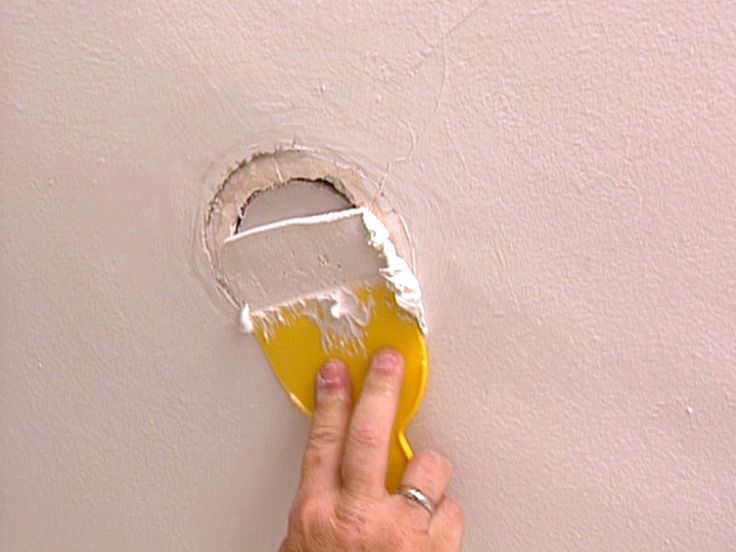
It is not so difficult to fix poorly sealed joints of plasterboard sheets. Of course, again you will have to remove most of the plastered layer, but the repair can still be attributed to the local and a complete rework of the entire structure is not required. By removing the putty in the right places and sealing the seams again, you will get a restored ceiling at no significant cost. It doesn't take too much time either.
If the puttying was not carried out on drywall sheets, but directly on the floor surface, in most cases the problem can be solved locally. If the applied layer cracks and peels off over a large area, then it would be wiser to completely remove the coating and carry out all surface leveling work again. However, this is most often not required in situations with minor flaws on plane
The very same cracks will lie at the joints of concrete slabs or on other parts of the surface if the drying technology is violated, and the putty itself was poorly mixed.

